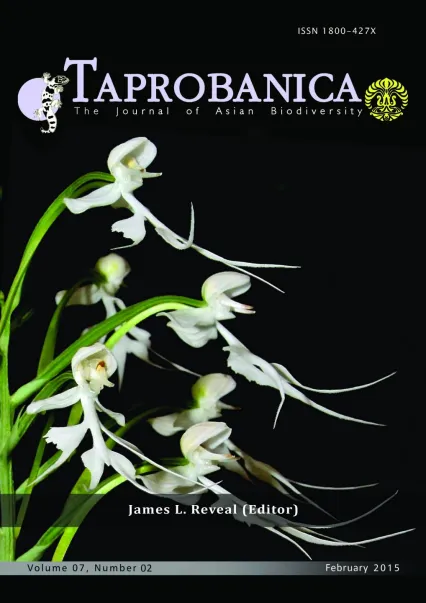

v7i2.168
Special Issue (Plants ) | Volume 7 | Number 2 | 2015
Major Article
ISSN: 1800-427X (print)
eISSN: 1800-427X (online)
DOI:10.47605/tapro.v7i2.168
Submitted date: 3 December 2014
Accepted date: 20 December 2014
Published date: 20 February 2015
Pp. 79–86.
HARVESTED PADDY FIELDS: AN UNDERSTUDIED ECOSYSTEM FROM THE NORTHERN WESTERN GHATS, INDIA
Sairandhri A. Lapalikar*, Ashish N. Nerlekar & Usha S. Yadav
*Corresponding author. E-mail: sairu1993@gmail.com
Abstract
This study was aimed at assessing the richness and obtaining allied ecological data of harvested rice fields at two sites around the town of Lonavala, northern Western Ghats, India. A total of ten fields were sampled (five at each site) using the quadrate method for the five post-harvest months. A total of 82 species were observed belonging to 74 genera of 31 families with Poaceae being the dominant family. Flora on the bunds and field proper was dissimilar. The natives and dicots species outnumbered the exotics and monocots respectively, and a gradual decline in the richness was observed from December through April. The PAST analysis indicated that some fields in the Tungi area were significantly different floristically from other fields. Presence of forests around the fields probably affects the post-harvest floristic diversity. Given that Indian farmers are experiencing a financial crisis, possible ways of gaining economic benefits out of this post-harvest floral diversity are discussed. Rice fields serve as a surrogate habitat for several species in areas disturbed due to anthropogenic activities and such studies provide baseline data for any future ecological studies.
Key words : exotic, floristics, native, Poaceae, post-harvest floral diversity, rice field
Section Editor: James L. Reveal
eISSN: 1800-427X (online)
DOI:10.47605/tapro.v7i2.168
Submitted date: 3 December 2014
Accepted date: 20 December 2014
Published date: 20 February 2015
Pp. 79–86.
HARVESTED PADDY FIELDS: AN UNDERSTUDIED ECOSYSTEM FROM THE NORTHERN WESTERN GHATS, INDIA
Sairandhri A. Lapalikar*, Ashish N. Nerlekar & Usha S. Yadav
*Corresponding author. E-mail: sairu1993@gmail.com
Abstract
This study was aimed at assessing the richness and obtaining allied ecological data of harvested rice fields at two sites around the town of Lonavala, northern Western Ghats, India. A total of ten fields were sampled (five at each site) using the quadrate method for the five post-harvest months. A total of 82 species were observed belonging to 74 genera of 31 families with Poaceae being the dominant family. Flora on the bunds and field proper was dissimilar. The natives and dicots species outnumbered the exotics and monocots respectively, and a gradual decline in the richness was observed from December through April. The PAST analysis indicated that some fields in the Tungi area were significantly different floristically from other fields. Presence of forests around the fields probably affects the post-harvest floristic diversity. Given that Indian farmers are experiencing a financial crisis, possible ways of gaining economic benefits out of this post-harvest floral diversity are discussed. Rice fields serve as a surrogate habitat for several species in areas disturbed due to anthropogenic activities and such studies provide baseline data for any future ecological studies.
Key words : exotic, floristics, native, Poaceae, post-harvest floral diversity, rice field
Section Editor: James L. Reveal
- List of Articles & Contents





